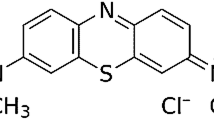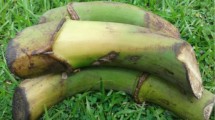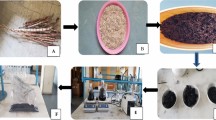Abstract
The existing approach of response surface methodology was extended to study the adsorption of methyl orange dye on optimized Acacia mangium wood-based activated carbon with a Brunauer, Emmett and Teller surface area of 1,767 m2/g. The experiments were carried out in a batch system, and the optimal condition was determined by means of the face-centered central composite design of response surface methodology. The effect of activated carbon dose, temperature and contact time on the adsorption capacity and percentage removal of methyl orange dye molecules were optimized. The experimental results indicated that the optimal conditions for the maximum adsorption capacity were 0.515 g/L, 55.0 °C and 24 h for adsorbent dose, temperature and contact time, respectively. Under these conditions, the maximum adsorption capacity and percentage removal were found to be 181 mg/g and 90.5 %, respectively. At optimized conditions of methyl orange dye removal, studies of the kinetic and thermodynamic behavior of adsorption revealed that it followed the pseudo-second-order rate model and was spontaneously endothermic in nature.






Similar content being viewed by others
Abbreviations
- U :
-
X A /X Ae, fractional attainment of equilibrium
- k n :
-
Net rate constant (1/min)
- k f :
-
Forward rate constant (1/min)
- k b :
-
Backward rate constant (1/min)
- X Ae and X A :
-
Fractional conversion of adsorbate into complex with adsorbent at equilibrium
- q e and q t :
-
Sorption capacities at equilibrium and at any instantaneous time t (mg/g)
- t :
-
Time (min)
- k 1 :
-
Rate constant of the pseudo-first-order kinetics (1/min)
- h :
-
Initial sorption rate as q t /t → 0, hence h = k 2·q 2e (mg/g/min)
- k 2 :
-
Rate constants for pseudo-second-order adsorption reaction (g/mg/min)
- C :
-
Boundary thickness (mg/g)
- ΔG°:
-
Standard change in free energy (kJ/mol)
- ΔH°:
-
Standard change in enthalpy (kJ/mol)
- ΔS°:
-
Standard change in entropy (kJ/K/mol)
- T :
-
Absolute temperature (K)
- K c :
-
Distribution co-efficient for the adsorption
- k d :
-
Intraparticle diffusion rate constant (mg/g/min1/2)
- R :
-
Universal gas constant (8.314 J/K/mol)
References
Ahmad AA, Hameed BH (2010) Effect of preparation conditions of activated carbon from bamboo waste for real textile wastewater. J Hazard Mater 173(1–3):487–493
Akmil-Başar C, Önal Y, Kılıçer T, Eren D (2005) Adsorptions of high concentration malachite green by two activated carbons having different porous structures. J Hazard Mater 127(1–3):73–80
Amini M, Younesi H (2009) Biosorption of Cd(II), Ni(II) and Pb(II) from aqueous solution by dried biomass of Aspergillus niger: application of response surface methodology to the optimization of process parameters. Clean: Soil Air Water 37(10):776–786
Anupam K, Dutta S, Bhattacharjee C, Datta S (2011) Adsorptive removal of chromium (VI) from aqueous solution over powdered activated carbon: optimisation through response surface methodology. Chem Eng J 173(1):135–143
Bezerra MA, Santelli RE, Oliveira EP, Villar LS, Escaleira LA (2008) Response surface methodology (RSM) as a tool for optimization in analytical chemistry. Talanta 76(5):965–977
Bhattacharya AK, Venkobachar C (1984) Removal of cadmium (II) by low cost adsorbents. J Environ Eng 110:110–122
Chen Z-X, Jin X-Y, Chen Z, Megharaj M, Naidu R (2011) Removal of methyl orange from aqueous solution using bentonite-supported nanoscale zero-valent iron. J Colloid Interface Sci 363(2):601–607
Crini G, Badot P-M (2008) Application of chitosan, a natural aminopolysaccharide, for dye removal from aqueous solutions by adsorption processes using batch studies: a review of recent literature. Prog Polym Sci 33(4):399–447
Danish M, Hashim R, Ibrahim MNM, Sulaiman O (2014) Optimized preparation for large surface area activated carbon from date (Phoenix dactylifera L.) stone biomass. Biomass Bioenergy 61:167–178
Fereidouni M, Daneshi A, Younesi H (2009) Biosorption equilibria of binary Cd(II) and Ni(II) systems onto saccharomyces cerevisiae and ralstonia eutropha cells: application of response surface methodology. J Hazard Mater 168(2–3):1437–1448
Garg VK, Kumar R, Gupta R (2004) Removal of malachite green dye from aqueous solution by adsorption using agro-industry waste: a case study of prosopis cineraria. Dyes Pigment 62(1):1–10
Ho YS, McKay G (1999) Pseudo-second order model for sorption processes. Process Biochem 34(5):451–465
Khuri AI, Cornell JA (1996) Response surfaces design and analysis. Marcel Dekker Inc, New York
Lagergren S (1898) About the theory of so-called adsorption of soluble substances. Kungliga Svenska Vetenskapsakademiens Handlingar 24:1–39
Malik PK (2004) Dye removal from wastewater using activated carbon developed from sawdust: adsorption equilibrium and kinetics. J Hazard Mater 113(1–3):81–88
Montgomery DC (1997) Design and analysis of experiments. Wiley, New York
Nigam P, Armour G, Banat IM, Singh D, Marchant R (2000) Physical removal of textile dyes from effluents and solid-state fermentation of dye-adsorbed agricultural residues. Bioresour Technol 72:219–226
Papic S, Koprivanac N, Metes A (2000) Optimizing polymer-induced flocculation process to remove reactive dyes from wastewater. Environ Technol 21(1):97–105
Prakashkumar BG, Miranda LR, Velan M (2005) Adsorption of Bismark Brown dye on activated carbons prepared from rubberwood sawdust (Hevea brasiliensis) using different activation methods. J Hazard Mater 126(1–3):63–70
Ramakrishna KR, Viraraghavan T (1997) Dye removal using low cost adsorbents. Water Sci Technol 36:189–196
Ryan TP (2007) Modern experimental design. Wiley, New Jersey, p 587
Sahu JN, Acharya J, Meikap BC (2010) Optimization of production conditions for activated carbons from Tamarind wood by zinc chloride using response surface methodology. Bioresour Technol 101(6):1974–1982
Sivakumar P, Palanisamy PN (2011) Non-conventional low-cost adsorbent from Euphorbia antiquorum L for the removal of Direct Blue 53 from its aqueous solution. Indian J Chem Technol 18(3):188–196
Treusch O, Hofenauer A, Tröger F, Fromm J, Wegener G (2004) Basic properties of specific wood-based materials carbonised in a nitrogen atmosphere. Wood Sci Technol 38(5):323–333
Tseng R-L, Wu F-C, Juang R-S (2003) Liquid-phase adsorption of dyes and phenols using pinewood-based activated carbons. Carbon 41(3):487–495
Weber WJ, Morris JC (1963) Kinetics of adsorption on carbon from solution. J Sanit Eng Div Am Soc Civ Eng 89:31–60
Wu F-C, Tseng R-L (2006) Preparation of highly porous carbon from fir wood by KOH etching and CO2 gasification for adsorption of dyes and phenols from water. J Colloid Interface Sci 294(1):21–30
Acknowledgments
The authors acknowledge the Universiti Sains Malaysia for providing research facilities and Postdoctorate Fellowship to Dr. Mohammed Danish.
Author information
Authors and Affiliations
Corresponding author
Rights and permissions
About this article
Cite this article
Danish, M., Hashim, R., Mohamad Ibrahim, M.N. et al. Response surface methodology approach for methyl orange dye removal using optimized Acacia mangium wood activated carbon. Wood Sci Technol 48, 1085–1105 (2014). https://doi.org/10.1007/s00226-014-0659-7
Received:
Published:
Issue Date:
DOI: https://doi.org/10.1007/s00226-014-0659-7




